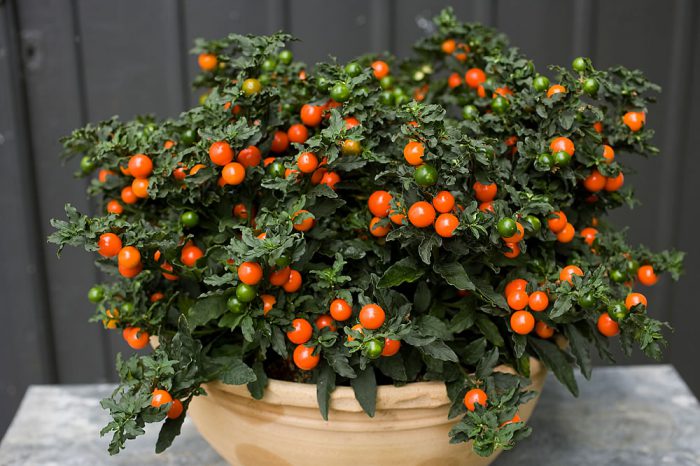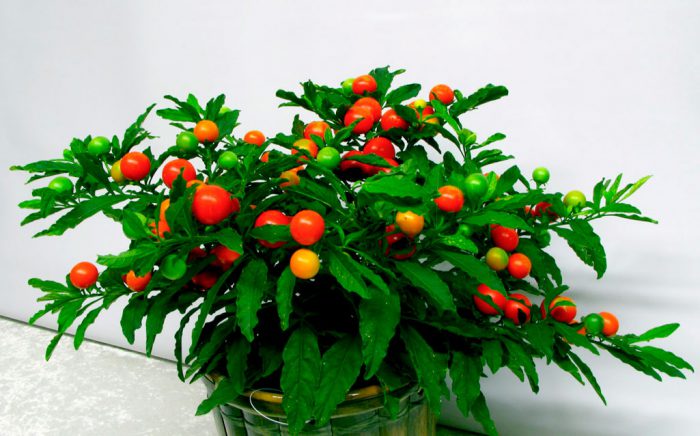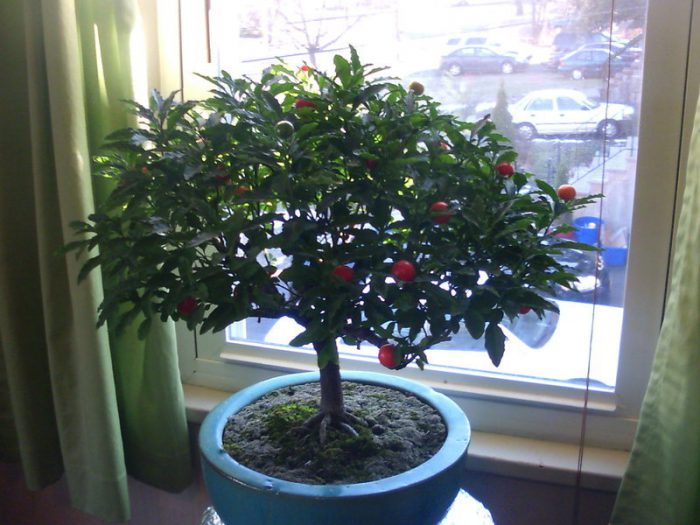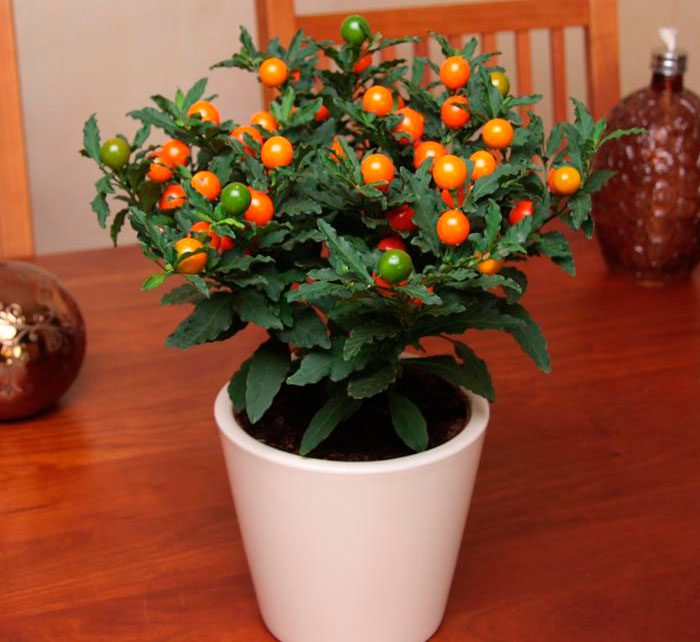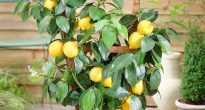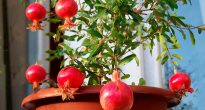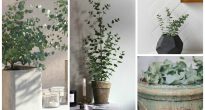Genus nightshade or, as it is also called, solanum (Solanum) is directly related to the nightshade family. In this genus, there are about 1000 species, among which there are both herbaceous plants and shrubs, as well as trees. They grow in temperate and warm climates around the globe. Under natural conditions, most often nightshade can be found in South America, the homeland of eggplant, tomato and potato.
At home, only a few species are grown, to which the False Nightshade (Solanum pseudocapsicum) belongs. This plant comes from several places at once, namely: from Ecuador, Peru, as well as the island of Madeiro. Under natural conditions, today it can be found in a large number of countries around the world, and in Australia for several centuries it has turned into a weed, which is not so easy to get rid of, which is a confirmation of the unpretentiousness of this nightshade.
Such an evergreen plant is compact and not very tall shrub. In the wild, it can reach a height of 100 centimeters, at home - somewhat less. Its lanceolate dark green leaves have slightly wavy edges, as well as short petioles.
Its small white flowers are collected in not very large racemose inflorescences, or they are single. Flowering can begin any month. However, the main decoration of this plant is its hearth. The fruit is a round berry with a diameter of 1 to 1.5 centimeters. They are colored red or rich orange. The fruits do not fall for a long time, so the bush is "decorated" almost all winter. In order to increase the time the berries stay on the bush, the nightshade should be placed in a cool room.
The dwarf forms of this home plant are most popular. They reach a height of no more than 30 centimeters, and their lush bushes are covered with a large number of berries. This plant is unpretentious in care and can be purchased in almost every specialty store. Often they are sold in winter, because it is during this period that such nightshade is one of the few plants that look very impressive.
Content
Is homemade nightshade a danger?
Any part of the nightshade is poisonous. In no case should you eat berries. They taste unpleasant, bitter, but small children can eat them out of curiosity.Despite the fact that they most likely will not eat a large amount of these fruits, they will most likely have indigestion. And it also happened that the child swallowed the fetus whole or thrust it into the respiratory tract.
Indoor nightshade is a dangerous plant, and it is not advised to grow it in the apartment where there are small children, it would be better to wait until they grow up.
Caring for nightshade at home
Illumination
This plant loves light very much and it is best if it is diffused. In a shaded place, it has very poor flowering, and its shoots are stretched, as a result of which decorativeness is lost. In the autumn-winter period, a window located in the southern part of the room is perfect for him. Since April, nightshade needs to be shaded from direct sunlight. In the warm season, it is recommended to move it to the veranda or balcony.
Temperature regime
In the summertime, it feels great at normal room temperature. Does not tolerate too high temperatures. And also the difference in temperature during the day and at night will be very useful for him (it should be cooler at night). In winter, it is recommended to lower the temperature to 12-15 degrees. If the room is cool, then the fruits will last longer on the branches. In the summer, the nightshade must be removed from the south window, as it will be very hot there.
How to water
During intensive growth and fruiting, systematic abundant watering is required. In winter, watering should be moderate, while the colder it is in the room, the less the plant is watered. However, the earthen coma should not be allowed to dry out. Spraying with lukewarm water is recommended.
Top dressing
In order for the plant to bloom and bear fruit abundantly, it needs a large amount of nutrients. The plant is fed in the spring-summer period 1 time in 2 weeks. For this, a complex fertilizer for flowering plants is used. In winter, you can not apply fertilizers to the soil or feed it 1 time in 4 weeks (you should use ½ part of the recommended dose).
Pruning
It tolerates pruning well. And they do it after the nightshade stops bearing fruit, so that it does not lose its decorative effect. In the last winter weeks, yellowing and falling foliage can often be observed. A procedure such as pruning significantly improves the condition of the plant. Be sure to shorten the main stem, as this will provoke the growth of lateral branches. And also their ends should be pinched.
Transfer
Transplanting is recommended in the first weeks of spring, before intensive growth begins. The soil should be used loose, easily air-permeable. Do not forget about a good drainage layer, which may consist of expanded clay. It is needed so that excess liquid can freely leave the pot. The plant is first pruned by about 1/3, and then planted in new soil.
This plant does not live very long. So, it grows soon enough and loses its decorative effect. Therefore, some growers advise not to transplant nightshade, but to root the stalk taken from it.
Earth mix
A suitable soil mixture consists of peat, turf and humus soil, as well as sand, taken in a ratio of 1: 1: 2: 1.
Fruiting
It may happen that there is flowering, but there are no berry ovaries. In the event that the plant is outdoors during flowering, then a slight wind is able to pollinate its flowers, transferring pollen. Indoor pollination may be required with a soft brush.
Pests and diseases
A spider mite can settle on a bush, but this is only if the room is too dry and warm. To get rid of it, it is recommended to systematically spray the nightshade, and the affected areas must be treated with an acaricidal agent.
Often, harmful insects settle on the bush while it is in the fresh air. So, in the summer, aphids can settle. For preventive purposes, nightshade must be treated with insecticides.
Reproduction methods
 You can propagate by cuttings or seeds.
You can propagate by cuttings or seeds.
The seeds can be sown on their own after a ripe berry has fallen, but the flower pot should be quite wide. Young grown plants can be transplanted into separate pots.
The sowing of the collected seeds is carried out in the spring, and a wide container is used for this. They should not be buried in the ground, but simply scattered over the surface and sprinkle a little with sand. For germination, place in warm (20-22 degrees) and cover with plastic.
In the spring-summer period, nightshade can be propagated by cuttings. For rooting, use a mixture of sand and peat, taken in equal parts. Cover the container with foil. The handle should have 2 to 4 leaves. To form a branchy bush, it is necessary to cut the plant several times in the summer.

